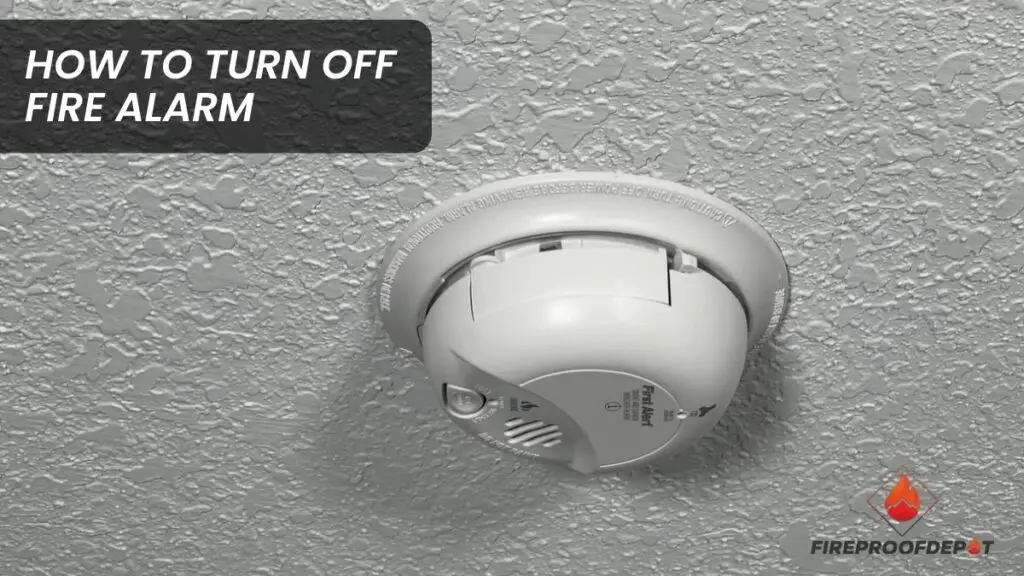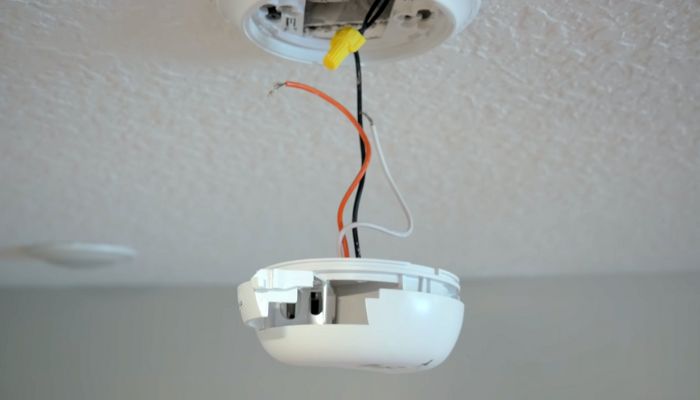Are you tired of the incessant blaring of your fire alarm? Whether it’s triggered by the smoke from cooking or a low battery causing annoying chirps or beeping, applying practical solutions to turn off and silence your fire alarm is necessary.
If you want to disable the alarm temporarily, you can remove the battery and unplug it. However, if you’re dealing with a chirping alarm, replacing the battery might be the solution.
Another handy technique is resetting the alarm, which can often resolve the issue without the need for battery replacement or purchasing a new model.
And, when the battery is absent, the accumulation of dust becomes a cause for the fire alarm’s persistent chirping, demanding a thorough cleansing to restore tranquility and ensure reliable operation.
Ensuring a dust-free environment for your fire alarm is crucial to avoid unwanted alarm sound when there is no battery inside.
Let’s delve into the ways you can successfully silence and troubleshoot your fire alarm.

What is a Fire Alarm System and How It Works
Fire alarm systems are crucial for detecting and alerting occupants of a building in the event of a fire emergency.
These systems consist of various components and features that work together to ensure timely and effective response. Here’s an overview of the key elements and functions of a typical fire alarm system:
Control Panel:
- Acts as the central command unit of the system.
- Monitors and controls all connected devices.
- Receives signals from smoke detectors, heat sensors, and manual pull stations.
Smoke Detectors:
- Detect the presence of smoke particles in the air.
- Trigger an alarm when smoke is detected.
- Types include ionization and photoelectric detectors, each with specific applications.
Heat Detectors:
- Sense changes in temperature.
- Suitable for areas where smoke detectors may not be effective, such as kitchens or boiler rooms.
- Trigger an alarm when a predefined temperature threshold is exceeded.
Manual Pull Stations:
- Manual devices for initiating an alarm.
- Located at strategic points throughout the building.
- Activated by pulling a handle or breaking a glass panel.
Notification Devices:
- Alert occupants through audible and visible signals.
- Include sirens, horns, strobe lights, and voice evacuation systems.
- Signal different alarm conditions, such as fire, evacuation, or system fault.
Monitoring and Communication:
- Fire alarm systems can be connected to a central monitoring station or directly to emergency services.
- Transmit alarm signals to ensure timely response.
- May include phone line connections, cellular or internet-based communication.
Stopping Battery-Powered Alarms – Step By Step
Whether you’re dealing with a low battery, false alarms, or simply need to silence the alarm temporarily, here’s a step-by-step guide to help you stop battery-powered fire alarms effectively:

Step 1: Identify the Source of the Alarm
Locate the fire alarm that is causing the disturbance. It is typically mounted on the ceiling or wall in a central area of the room or hallway.
Step 2: Assess the Alarm Condition
Determine the reason behind the alarm activation. Is it a low battery, smoke detection, or a false alarm triggered by cooking or steam?
Step 3: Prepare for Disabling the Alarm
Put on protective gloves if necessary to avoid any potential injury while handling the alarm. Safety first!
Step 4: Remove the Battery
Carefully remove the battery cover from the fire alarm. In most cases, it can be opened by sliding or twisting the cover.
Step 5: Extract the Battery
Take out the battery from the alarm by gently pulling it out from its compartment. Ensure proper disposal of the battery according to local regulations.
Step 6: Unplug the Alarm (optional)
If your fire alarm is also connected to a power source via a plug, you can unplug it to disable the alarm completely.
Step 7: Troubleshooting False Alarms
If the alarm was triggered by cooking or steam, use a towel or fan to disperse the smoke or steam around the alarm until it shuts off. Make sure to address the source of the smoke or steam to prevent further alarms.
Step 8: Address Low Battery Issues
If the alarm was chirping to indicate a low battery, replace the old battery with a fresh one of the same type. Follow the manufacturer’s instructions for proper installation.
Step 9: Test the Alarm (after resolving the issue)
Once the alarm has been silenced or the battery has been replaced, test the functionality of the fire alarm by pressing the designated test button. Ensure that it activates properly and emits a loud sound.
Note: Regularly inspect your fire alarms to ensure they are free from dust or debris. Replace the batteries as recommended by the manufacturer or when the low-battery indicator activates.
Fire alarms are crucial for your safety, and disabling them should only be a temporary measure. It is essential to address the underlying issue promptly.
Turning Off Hardwired Alarms – Step By Step
Hardwired fire alarms are an integral part of fire safety systems in many buildings. However, there may be instances where you need to turn off the alarm temporarily for maintenance, false alarms, or other reasons.

Here is a step-by-step guide to help you turn off hardwired fire alarms effectively:
Step 1: Locate the Control Panel
The control panel is the central hub of the fire alarm system. Find the control panel, which is usually located in a utility room, electrical closet, or near the main entrance.
Step 2: Access the Control Panel
Open the control panel by using a key or following the manufacturer’s instructions. Some control panels may have a latch or lock mechanism.
Step 3: Identify the Alarm Circuit
Inside the control panel, locate the circuit breaker or switch that corresponds to the specific alarm you want to turn off. The circuit breaker is typically labeled or numbered for identification.
Step 4: Turn Off the Circuit Breaker
Switch off the circuit breaker that controls the alarm circuit you wish to disable. This will interrupt the power supply to the alarm, effectively turning it off.
Step 5: Test the Alarm (optional)
After disabling the alarm, you may want to test it to ensure it is no longer active. Activate the fire alarm system using the designated test button on the control panel. Verify that the disabled alarm does not sound.
Step 6: Address the Reason for Disabling
Determine the reason behind turning off the fire alarm. If it was due to maintenance or repairs, make sure to complete the necessary tasks before restoring power to the alarm.
Step 7: Restore Power to the Alarm
Once the maintenance or repair work is completed, go back to the control panel and switch on the circuit breaker for the specific alarm circuit. This will restore power to the fire alarm.
Step 8: Verify Alarm Functionality
After restoring power, test the fire alarm system again to ensure that the disabled alarm is functioning correctly. Press the designated test button on the control panel and confirm that the alarm sounds as expected.
Situations Where Turning Off a Fire Alarm Is Necessary
There are certain scenarios where the temporary deactivation of a fire alarm becomes necessary for specific purposes. Here are a few situations where turning off a fire alarm might be required:
- Maintenance and Testing: During routine maintenance or testing procedures of the fire alarm system, selectively turning off specific alarms ensures accurate evaluations without causing unnecessary disruptions or false alarms.
- Construction or Renovation: In construction or renovation areas where dust, debris, or potentially disruptive activities are present, temporarily disabling fire alarms prevents false alarms and minimizes disruptions to workers.
- Known False Alarms: If there is a known issue or malfunction causing repeated false alarms from a specific fire alarm, temporarily turning it off allows for investigations, repairs, or adjustments to be carried out without causing unnecessary interruptions.
- Emergency Drills: During planned emergency drills or training exercises, certain fire alarms may be turned off to prevent unnecessary panic or confusion among participants, while still ensuring the effectiveness of the overall emergency response plan.
- Special Events: In rare cases where special events or performances are held in close proximity to fire alarms, the temporary deactivation of specific alarms can prevent unintended activations due to stage effects, smoke machines, or pyrotechnics.
Final Words
So, in moments where you need to turn off a fire alarm, whether due to false alarms, maintenance, or specific situations, remember to approach it with caution and ensure it is only a temporary measure.
Whether it’s through disconnecting the power source, removing the battery, or seeking professional assistance, prioritizing safety and prompt reactivation is key.
Regular maintenance, testing, and adhering to fire safety protocols will help maintain the effectiveness of fire alarm systems in safeguarding lives and property.
Stay vigilant and proactive in fire safety practices to ensure a secure environment.
Thanks for reading till the end!
